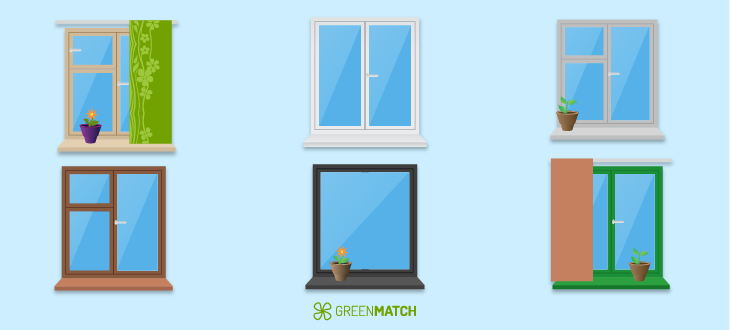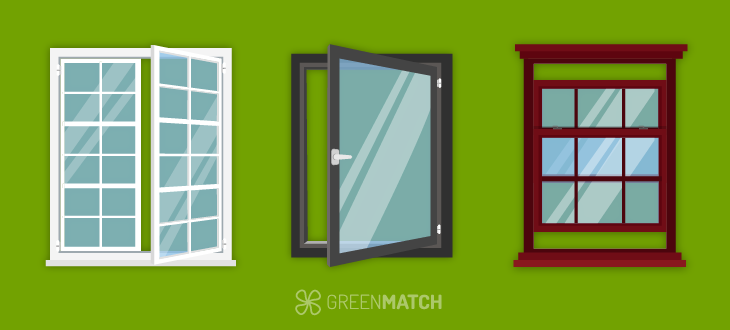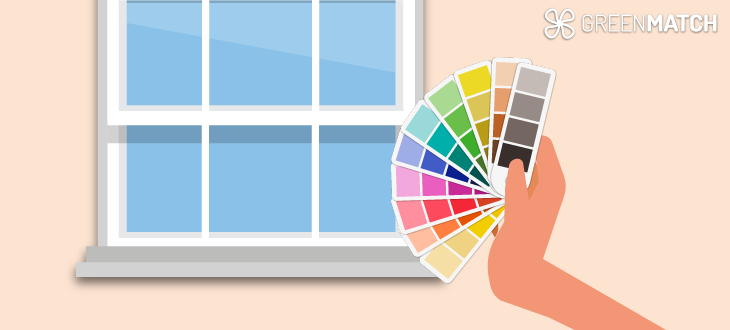Answer these simple questions and we will find you the BEST prices
Which type of solar quotes do you need?
It only takes 30 seconds
100% free with no obligation



- GreenMatch
- Blog
- Choosing Window Frame Colours
How to Choose the Perfect Window Frame Colours for Your Home

Selecting the appropriate colour for your window frames is a crucial element of the home design that can significantly impact your home's overall appearance and ambience. The right window frame colour for your home can accentuate your home's style, complement its overall aesthetic, and boost curb appeal. However, it's important to consider the style of your home's architecture when making this decision.
Traditional styles lean toward warm colours like reds, yellows, oranges, and browns, while modern designs lean toward cooler tones like greens, blues, purples, and greys. Black and white window frames work well with most design styles. The colour of the exterior siding material also impacts the home's feel. For a traditional style, the colour of the window frame should pop out or contrast with the house's colours, while for a modern style, the colour of the window frames should be similar or blend in with the house's colours.

Creating a design plan for the window frame
Creating a design plan for your window frame is important in choosing the right colour for your home. By considering the style of your home's architecture, the colours of your home's exterior siding material, and your style, you can narrow down your options and choose a colour that will enhance the beauty of your property.
Keeping a few key factors in mind when deciding on a window colour frame is important. We consulted with some experts, and here are some tips to consider when choosing colours to complete your home.
Window frame tips to transform the look and feel of your living space
- Consider your style and preferences. Pick colours that reflect your personality, family, and what you like. Picking a colour scheme is one of the most daunting tasks when decorating your home, but it's important to choose colours that you love and that make you feel comfortable.
- Look for inspiration. Consider catalogues, magazines, and websites for inspiration when selecting paint colours for your home. A jumbled collection of colour cards in fifty shades of your preferred colour can be overwhelming, so it's important to have a starting point.
- Create a design plan. Before choosing colours, create a design plan for your home. This will help you determine the overall style and colour palette you want. Once you know the context of the type and broad colour palette, you can work through which options will coordinate.
- Consider the lighting in your home. It is important to consider the varying lighting in your room before finalising a colour palette. Make sure you think through how various colours and textures will look in different lighting conditions.
- Establish a cohesive colour palette throughout the entire house. A great tip for choosing interior paint colours for your home is to establish a coherent colour palette throughout the whole house that can also complement the exterior of your home.
- Feel free to mix and match. You don't have to stick to one colour throughout your home. Mixing and matching colours can add depth and interest to your space.
- Consider the impact of window frame colour. The window frame colour can set the tone for the rest of your exterior decisions. Choosing a colour that will coordinate well with the rest of your exterior is important.

Different Colours for Window Frames
Choosing the right colour for your window frames can be a daunting task. With many options available, figuring out where to start can take time. The colour of your window frame can make a significant difference in the feel and look of your home, significantly impacting the overall look. By considering the style of your home, the colours of your home's exterior siding material, and your style, you can narrow down your options and choose a colour that will enhance the beauty of your property.
Here are some of the most popular window frame colours and what they can bring to your home:
- White: White is a classic and timeless colour for window frames. It works well with any home style, making your windows look larger and more prominent. White frames also reflect light, which can help keep your home cooler in the summer.
- Black: Black window frames are popular for modern window frame colour ideas and contemporary homes. They can add a sleek and sophisticated look to your home and make your windows look like works of art. Black frames also provide a nice contrast against light-coloured walls.
- Brown: Brown window frames are the best colours for traditional and rustic homes. They can add warmth and depth to your home and complement natural wood finishes. Brown frames also work well with earthy tones, creating a cosy and inviting atmosphere.
- Grey: Grey window frames are a versatile choice that can work with many different styles of homes. They can add a modern, sophisticated look to your home and complement the light and dark-coloured walls. Grey frames also provide a nice contrast against white or cream-coloured walls.
- Cream: Cream window frames are a neutral and understated choice that can work well with many different styles of homes. They can add warmth and depth to your home and complement light and dark-coloured walls. Cream frames also provide a nice contrast against white walls.
- Green: Green window frames are a unique and bold choice that can add character and personality to your home. They work well with natural surroundings and can complement homes with greenery. Green frames also provide a nice contrast against light-coloured walls.
| Colour Option | Pros | Cons |
|---|---|---|
| Classic White | - Timeless appeal - Versatile, complements any colour scheme - Creates bright, clean appearance - Reflects heat, potentially improving energy efficiency | - Shows dirt and grime easily - Can appear generic. - May lack contrast against light exteriors |
| Sophisticated Black | - Provides striking contrast - Creates sleek, contemporary look - Frames views dramatically - Hides dirt and smudges well | - Shows dust easily - Can absorb more heat - Might not appeal to all potential buyers |
| Versatile Gray | - Complements various architectural styles - Offers softer contrast than black - Hides dirt better than white - Available in various shades | - Lighter shades may show weathering quickly - Can appear cold or industrial if not balanced |
| Natural Wood Tones | - Adds warmth and natural beauty - Complements traditional/rustic styles - Available in various tones - Can be stained or painted | - Requires more maintenance (real wood) - May not suit modern designs - Can be more expensive |
| Bold Colors (e.g., red, blue, green) | - Creates distinctive appearance - Allows for personal expression - Can complement other design elements | - May limit future colour scheme changes - Could affect resale value - Might require frequent repainting |
| Matching Home's Exterior | - Creates cohesive, streamlined look - Can make home appear larger - Provides subtle, sophisticated appearance | - May lack visual interest - Could make windows less noticeable - Might require changing if the exterior is repainted |
It is worth noting that when choosing the colour of your window frames, they are available in various materials and styles, each with advantages and disadvantages. Some common materials include wood, vinyl, aluminium, fibreglass, wood-clad, and composite. Think about how you want your windows to be opened and closed and whether you want features like screens or grilles.
Consider the location of your windows and whether you need features such as tempered glass for safety, double-glazed, casement, bay or awning windows. Consider durability, maintenance requirements, and cost when choosing a frame material.

Think about the climate when choosing your window frame
When choosing a colour theme, one important fact is considering your climate, looking for energy-efficient options, selecting a colour that complements your home's exterior, considering the style of your home, and consulting with experts. You can choose a colour that will enhance the beauty of your property and keep your home comfortable year-round.
Your window frames can affect the temperature inside your home. Dark colours absorb more heat than light, so if you live in a hot climate, consider lighter-coloured structures to keep your home cooler. This principle applies to window frames as well. Energy-efficient windows can keep your home comfortable year-round, regardless of your environment. Look for windows with low-E coatings, which can reflect heat and UV rays.
''The colour of your window frames subtly impacts the temperature inside your home. Darker colours, such as deep browns or black, tend to absorb more heat from sunlight, potentially raising the temperature slightly within the vicinity of the windows. On the other hand, lighter colours like white or beige reflect more heat, which can help keep the interior cooler''. Jacky Chou. Principal and Director at Archute.
The style of your home can also impact the colour of your window frames. Traditional styles lean toward warm colours like reds, yellows, oranges, and browns, while modern designs lean toward cooler tones like greens, blues, purples, and greys. If you are still trying to decide which colour to choose, consult with experts. They can guide you in determining the perfect window frame colour for your home.
According to an expert, the colour of your window frames should complement the colour of your home's exterior. Look for colours that work well with your home's existing colour palette.
“Consider the existing colours of your home's exterior, including the siding, trim, and roof. Look for window frame colours that complement or create a pleasing contrast with these existing elements. You can use colour swatches or consult with a professional for guidance.” Samatha Odo, Real Estate

Compliment your window with energy-efficient designs
Energy-efficient windows prevent heated or cooled air from escaping your home, reducing energy bills and maintaining a more consistent indoor temperature. While frame colour plays a role in energy efficiency, keeping perspective is important. Experts agree that other factors have a much more significant impact on a window's overall energy performance.
- Frame material (e.g., vinyl, fibreglass, wood)
- Glass type (e.g., double-pane, low-E coatings)
- Quality of installation
- Overall window design
Here are some of the top energy-efficient windows based on various sources:
- Ply Gem® High-Performance R-5 Windows: These windows are highly insulating, making them one of the most energy-efficient windows on the market. They are ideal for cold and mixed climates. An R-value of 5 means that these windows have reduced heat loss from a U-factor of 0.3 to 0.2, saving consumers more than 30% on energy bills.
- Andersen® Windows with the EcoExcel™ energy performance package: These windows are 70% more energy-efficient in the summer and 45% more energy-efficient in winter than standard dual pane glass.
- Milgard® Windows 3D® and 3D MAX® Energy Packages: These energy packages address all three critical areas of efficiency — framework, product design, and glazing — by matching them to the region's climate where the windows are installed.
- Renewal by Andersen: This company is recommended for its unique, energy-efficient Fibrex window material.
- Double-pane and triple-pane glass windows are the most common types of window glass used in energy-efficient homes. The more insulative the frame material is, the more energy-efficient the glass will be, which is why triple-pane windows are the most highly recommended.
- Pella® 250 Series Windows: These windows emphasize energy efficiency with multiple insulating frame chambers and an exclusive weather-repel system. Their upgraded triple-pane windows are 62% more energy-efficient window frame options than single-pane windows.
Remember, the best energy-efficient window for your home will depend on your location, climate, budget, and what you're upgrading from. It's recommended to take advantage of window providers' free estimates and consultations and schedule appointments with representatives from multiple window brands.
Answer these simple questions and we will find you the BEST prices
Matching window frame colours with architectural styles
Choosing the right window frame colour is not just about personal preference; it also involves considering the architectural style of your home. Different styles can be complemented or contrasted with specific colours to enhance the overall aesthetic.
Here are some targeted recommendations for various home types:
| Architectural Style | Recommended Colors | Description |
|---|---|---|
| Traditional Homes | Classic White, Black | White offers a timeless look, while black adds sophistication and a modern twist. |
| Modern and Contemporary | Dark Charcoal, Black, and Metallic Finishes | Dark colours provide a sleek, modern look; metallic finishes add an industrial touch. |
| Rustic and Cottage Homes | Warm Earth Tones (Beige, Taupe, Warm Gray), Forest Green, Deep Brown | Earth tones blend with natural surroundings; green and brown add a subtle pop of colour. |
| Mediterranean and Tuscan | Terracotta, Warm Brown, Cream, Off-White | Warm colours create a cohesive look; cream offers a softer contrast. |
| Modern Farmhouse | Black, Dark Gray, White | Black and grey contrast strikingly; white offers a seamless, elegant appearance. |
| Coastal Homes | Light Blue, Aqua, White | Blue and aqua reflect the coastal environment; white offers a crisp, clean look. |
| Craftsman and Bungalow | Earthy Greens and Browns, Muted Reds, Blues | Earthy colours enhance natural materials; muted reds and blues add character while maintaining appeal. |
Don't be afraid to stand out
While choosing a colour that complements your home's existing colour palette and the surrounding environment is important, don't be afraid to stand out. A bold colour can make your home stand out and look beautiful if done tastefully. Consider using a bold colour for your front door or shutters or as an accent colour on your home's exterior.

Another important factor to consider when choosing a colour for your home's exterior is the surrounding environment. Look at the colours of the trees, plants, and other natural features around your home, and choose a colour that complements them. For example, a warm beige or cream colour can be a good choice if green trees surround your home.
Like with interior design, colour can help create a mood for your home's exterior. For example, if you want your home to feel welcoming and inviting, warm colours like red, orange, and yellow can be a good choice. On the other hand, if you want your home to feel calm and serene, cool colours like blue, green, and purple can be a good choice.
“The material of the window frame, the choice of paint, and the application process are all determinants of resilient window frames. For example, fiberglass window frames are a great choice. This type of material is resilient and can last homeowners a long time. It is also important to select high-quality paint. You should avail the services of a professional contractor for the paint application process.” Jasen Edwards, Chair of the Agent Editorial Board.
Making the Right Choice
So, should you choose your window frame colour based solely on energy efficiency? Not necessarily. Here's a balanced approach:
- Prioritise quality: Choose high-quality, energy-efficient windows with appropriate materials and glass for your climate.
- Consider your home's style: Select a colour that complements your home's architecture and personal taste.
- Factor in climate: If you live in an extreme climate, consider how the frame colour might contribute to your overall energy strategy.
- Consult an expert: When in doubt, consult a window professional who can provide tailored advice for your situation.
Choosing the right colour for your home's exterior is important for creating a beautiful and cohesive look. Consider the mood you want to create, your home's existing colour palette, and the surrounding environment, and don't be afraid to stand out.
Remember, while frame colour can have a minor impact on energy efficiency, it shouldn't be the deciding factor in your window choice. The most energy-efficient windows combine quality materials, proper installation, and smart design – regardless of their colour.
With these tips, you can choose a colour to make your home look beautiful and unique.
“Do you already know what colour you want? GreenMatch can help you compare window quotes. Do not hesitate to fill out the contact form for more information from our trusted suppliers! It’s free, easy, and energy efficient!
”Do you already know what colours you want? GreenMatch can help you compare up to 3 quotes.’’

Inemesit is a seasoned content writer with 9 years of experience in B2B and B2C. Her expertise in sustainability and green technologies guides readers towards eco-friendly choices, significantly contributing to the field of renewable energy and environmental sustainability.
We strive to connect our customers with the right product and supplier. Would you like to be part of GreenMatch?

